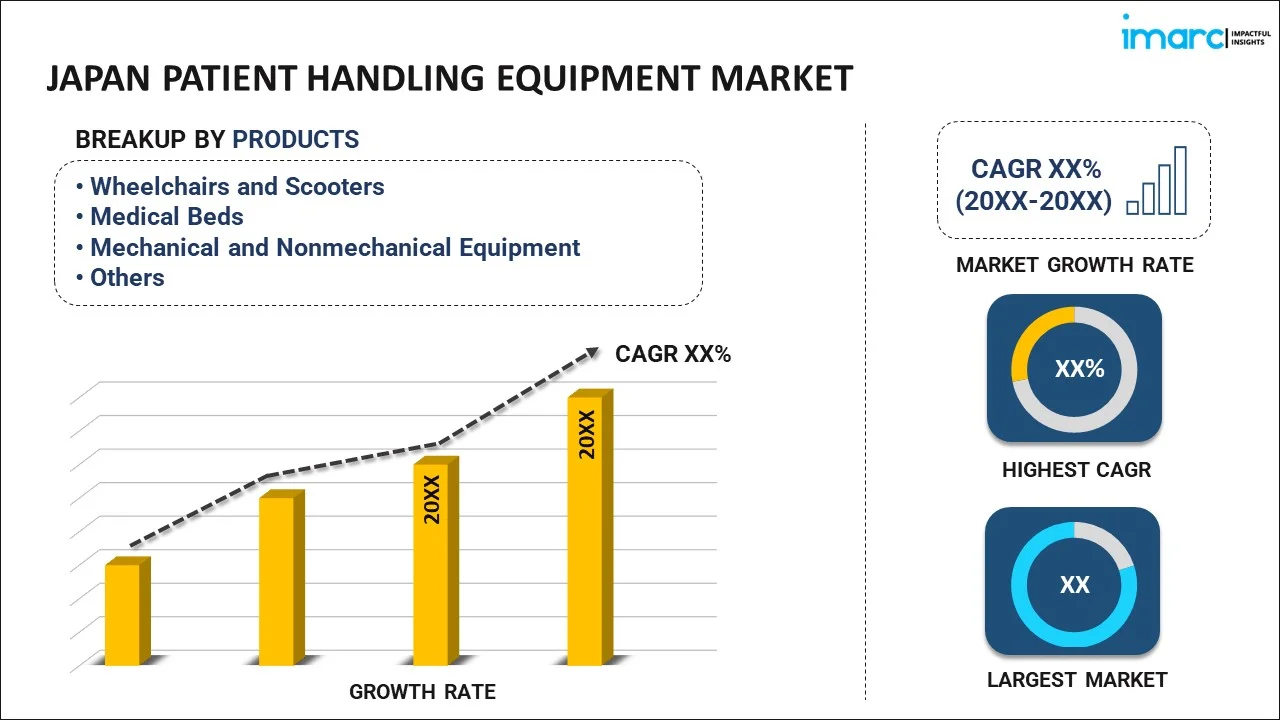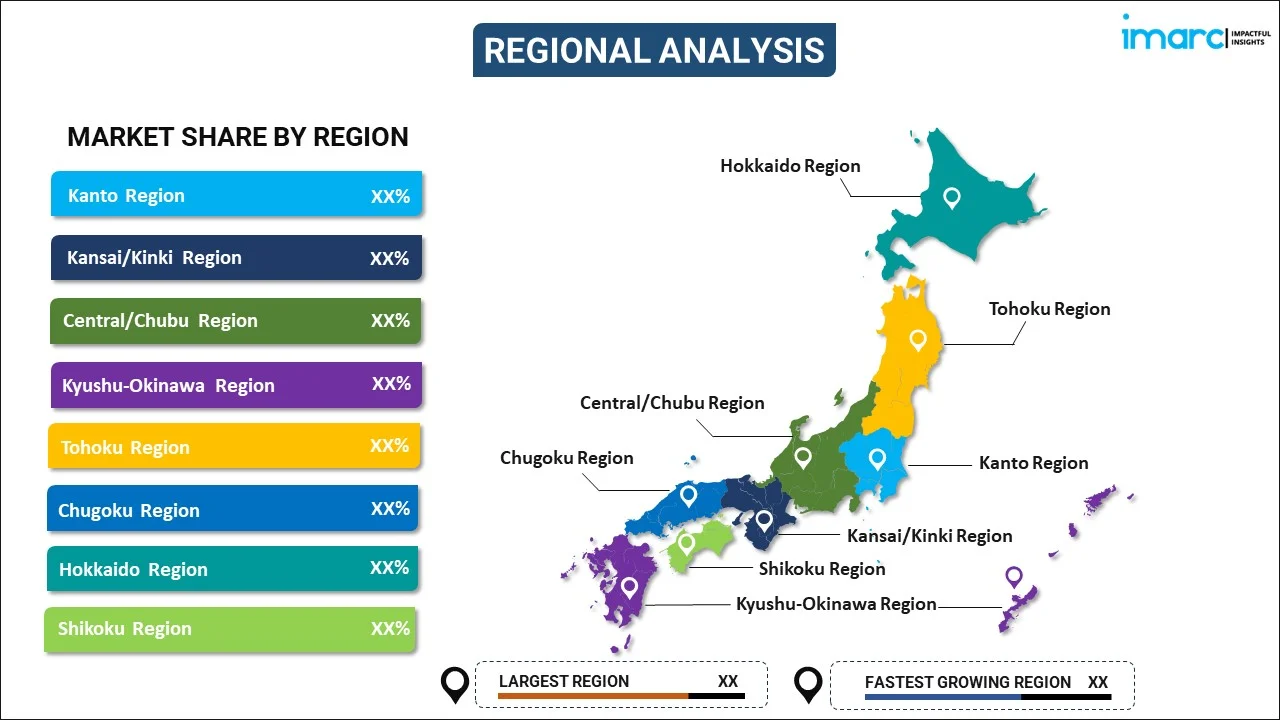
Japan Patient Handling Equipment Market Report by Product (Wheelchairs and Scooters, Medical Beds, Mechanical and Nonmechanical, Equipment, Ambulatory Aids, and Others), Type of Care (Bariatric Care, Fall Prevention, Critical Care, Wound Care, and Others), End User (Hospitals, Home Care Settings, Elderly Care Facilities, and Others), and Region 2025-2033
Market Overview:
Japan patient handling equipment market size reached USD 886.6 Million in 2024. Looking forward, IMARC Group expects the market to reach USD 1,479.0 Million by 2033, exhibiting a growth rate (CAGR) of 5.4% during 2025-2033. The growing healthcare standards in Japan, the development of user-friendly, ergonomic, efficient, innovative patient-handling equipment, and the implementation of stringent healthcare standards and regulations to ensure the safety and comfort of patients represent some of the key factors driving the market.
|
Report Attribute
|
Key Statistics
|
|---|---|
|
Base Year
|
2024
|
|
Forecast Years
|
2025-2033
|
|
Historical Years
|
2019-2024
|
|
Market Size in 2024
|
USD 886.6 Million |
|
Market Forecast in 2033
|
USD 1,479.0 Million |
| Market Growth Rate 2025-2033 | 5.4% |
Patient handling equipment refers to several specialized devices and tools developed to assist healthcare professionals in safely and effectively moving and transporting patients. These essential pieces of equipment ensure the well-being of patients and healthcare providers, minimizing the risk of injury during various medical procedures and transfers. Some common types of patient handling equipment are patient lifts, transfer aids, specialized beds and mattresses, ambulation aids, wheelchairs, patient slings, patient repositioning aids, bath and shower aids, patient transport equipment, and fall prevention devices. Additionally, devices, including ambulation aids, such as walkers and canes, are essential for patients who require support while walking to help patients regain their mobility and independence. For instance, patient lifts are available in various forms, including hydraulic, electric, and manual models that are utilized to lift and transfer patients from one surface to another, such as from a bed to a wheelchair or vice versa, and reduce the physical strain on healthcare workers and enhances patient comfort and safety. Also, transfer aids include items such as transfer boards, slide sheets, and transfer belts and facilitate the smooth movement of patients between several surfaces and positions, ensuring that transfers are as seamless and risk-free as possible. Consequently, patient-handling equipment is gaining immense traction across the region.
Japan Patient Handling Equipment Market Trends:
The market is primarily driven by the growing healthcare standards in Japan. In addition, the implementation of stringent healthcare standards and regulations ensures the safety and comfort of patients and encourages healthcare facilities to invest in advanced patient-handling equipment that meets regulatory requirements. As a result, there is a growing demand for modern, technologically advanced patient-handling solutions that can enhance patient care and reduce the risk of injuries to patients and healthcare providers. Moreover, several advancements in healthcare technology led to the development of innovative patient-handling equipment that is developed to be user-friendly, ergonomic, and efficient, catering to the specific needs of healthcare professionals, representing another major growth-inducing factor. Also, motorized patient lifts, smart monitoring systems and advanced mobility aids are gaining popularity in Japan due to their ability to enhance patient care and improve the working conditions of healthcare staff, augmenting the market growth. Besides this, continuous investment in healthcare infrastructure and the expansion of hospital facilities are contributing to the patient-handling equipment market. Along with this, newly constructed and renovated healthcare facilities are equipped with the latest patient-handling solutions to provide high-quality care and ensure patient comfort, propelling the market growth. Furthermore, the growing geriatric population is facing mobility issues and requires assistance in various healthcare settings, such as hospitals, nursing homes, and home care, creating a positive market outlook across Japan.
Japan Patient Handling Equipment Market Segmentation:
IMARC Group provides an analysis of the key trends in each segment of the market, along with forecasts at the country level for 2025-2033. Our report has categorized the market based on product, type of care, and end user.
Product Insights:

- Wheelchairs and Scooters
- Medical Beds
- Mechanical and Nonmechanical Equipment
- Ambulatory Aids
- Others
The report has provided a detailed breakup and analysis of the market based on the product. This includes wheelchairs and scooters, medical beds, mechanical and nonmechanical equipment, ambulatory aids, and others.
Type of Care Insights:
- Bariatric Care
- Fall Prevention
- Critical Care
- Wound Care
- Others
A detailed breakup and analysis of the market based on the type of care have also been provided in the report. This includes bariatric care, fall prevention, critical care, wound care, and others.
End User Insights:
- Hospitals
- Home Care Settings
- Elderly Care Facilities
- Others
The report has provided a detailed breakup and analysis of the market based on the end user. This includes hospitals, home care settings, elderly care facilities, and others.
Regional Insights:

- Kanto Region
- Kansai/Kinki Region
- Central/ Chubu Region
- Kyushu-Okinawa Region
- Tohoku Region
- Chugoku Region
- Hokkaido Region
- Shikoku Region
The report has also provided a comprehensive analysis of all the major regional markets, which include Kanto Region, Kansai/Kinki Region, Central/ Chubu Region, Kyushu-Okinawa Region, Tohoku Region, Chugoku Region, Hokkaido Region, and Shikoku Region.
Competitive Landscape:
The market research report has also provided a comprehensive analysis of the competitive landscape in the market. Competitive analysis such as market structure, key player positioning, top winning strategies, competitive dashboard, and company evaluation quadrant has been covered in the report. Also, detailed profiles of all major companies have been provided.
Japan Patient Handling Equipment Market Report Coverage:
| Report Features | Details |
|---|---|
| Base Year of the Analysis | 2024 |
| Historical Period | 2019-2024 |
| Forecast Period | 2025-2033 |
| Units | Million USD |
| Scope of the Report | Exploration of Historical Trends and Market Outlook, Industry Catalysts and Challenges, Segment-Wise Historical and Future Market Assessment:
|
| Products Covered | Wheelchairs and Scooters, Medical Beds, Mechanical and Nonmechanical, Equipment, Ambulatory Aids, Others |
| Type of Cares Covered | Bariatric Care, Fall Prevention, Critical Care, Wound Care, Others |
| End Users Covered | Hospitals, Home Care Settings, Elderly Care Facilities, Others |
| Regions Covered | Kanto Region, Kansai/Kinki Region, Central/ Chubu Region, Kyushu-Okinawa Region, Tohoku Region, Chugoku Region, Hokkaido Region, Shikoku Region |
| Customization Scope | 10% Free Customization |
| Post-Sale Analyst Support | 10-12 Weeks |
| Delivery Format | PDF and Excel through Email (We can also provide the editable version of the report in PPT/Word format on special request) |
Key Questions Answered in This Report:
- How has the Japan patient handling equipment market performed so far and how will it perform in the coming years?
- What has been the impact of COVID-19 on the Japan patient handling equipment market?
- What is the breakup of the Japan patient handling equipment market on the basis of product?
- What is the breakup of the Japan patient handling equipment market on the basis of type of care?
- What is the breakup of the Japan patient handling equipment market on the basis of end user?
- What are the various stages in the value chain of the Japan patient handling equipment market?
- What are the key driving factors and challenges in the Japan patient handling equipment?
- What is the structure of the Japan patient handling equipment market and who are the key players?
- What is the degree of competition in the Japan patient handling equipment market?
Key Benefits for Stakeholders:
- IMARC’s industry report offers a comprehensive quantitative analysis of various market segments, historical and current market trends, market forecasts, and dynamics of the Japan patient handling equipment market from 2019-2033.
- The research report provides the latest information on the market drivers, challenges, and opportunities in the Japan patient handling equipment market.
- Porter's five forces analysis assist stakeholders in assessing the impact of new entrants, competitive rivalry, supplier power, buyer power, and the threat of substitution. It helps stakeholders to analyze the level of competition within the Japan patient handling equipment industry and its attractiveness.
- Competitive landscape allows stakeholders to understand their competitive environment and provides an insight into the current positions of key players in the market.
Need more help?
- Speak to our experienced analysts for insights on the current market scenarios.
- Include additional segments and countries to customize the report as per your requirement.
- Gain an unparalleled competitive advantage in your domain by understanding how to utilize the report and positively impacting your operations and revenue.
- For further assistance, please connect with our analysts.
 Inquire Before Buying
Inquire Before Buying
 Speak to an Analyst
Speak to an Analyst
 Request Brochure
Request Brochure
 Request Customization
Request Customization




.webp)




.webp)












